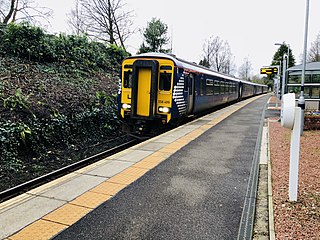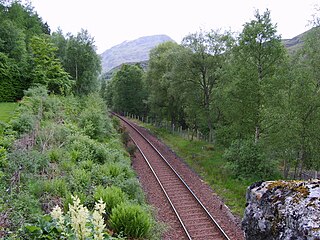
Argyll and Bute is one of 32 unitary council areas in Scotland and a lieutenancy area. The current lord-lieutenant for Argyll and Bute is Jane Margaret MacLeod. The administrative centre for the council area is in Lochgilphead at Kilmory Castle, a 19th-century Gothic Revival building and estate. The current council leader is Robin Currie, a councillor for Kintyre and the Islands.

The West Highland Line is a railway line linking the ports of Mallaig and Oban in the Scottish Highlands to Glasgow in Central Scotland. The line was voted the top rail journey in the world by readers of independent travel magazine Wanderlust in 2009, ahead of the notable Trans-Siberian line in Russia and the Cuzco to Machu Picchu line in Peru. The ScotRail website has since reported that the line has been voted the most scenic railway line in the world for the second year running.

Corrour railway station is on the West Highland Line, near Loch Ossian on the Corrour Estate, in the Highland Region of Scotland. It is the highest mainline railway station in the United Kingdom. It is located between Rannoch and Tulloch, and is sited 71 miles 54 chains (115.3 km) from Craigendoran Junction, near Helensburgh. ScotRail manage the station and provide most services, along with Caledonian Sleeper.

Arrochar and Tarbet railway station is a railway station on the West Highland Line in Scotland. It stands between the villages of Arrochar and Tarbet. It is sited 19 miles 45 chains (31.5 km) from Craigendoran Junction, near Helensburgh, between Ardlui and Garelochhead. ScotRail manage the station and operate most services, with others provided by Caledonian Sleeper.

Helensburgh Upper railway station serves the town of Helensburgh, Scotland, on the north shore of the Firth of Clyde to the west of Glasgow. It is located in a residential area uphill from the town centre and is by far the smaller of the town's two stations. It is on the West Highland Line, 2 miles 8 chains (3.4 km) from Craigendoran Junction, near Helensburgh, the first station on the line before Garelochhead. ScotRail manage the station and operate most services, with others provided by Caledonian Sleeper.

Ardlui railway station is a rural railway station, serving Ardlui at the north end of Loch Lomond, in Scotland. The station is located on the West Highland Line, sited 27 miles 43 chains (44.3 km) from Craigendoran Junction, near Helensburgh, between Crianlarich and Arrochar and Tarbet. ScotRail manage the station and operate most services, others provided by Caledonian Sleeper.

Garelochhead railway station is a railway station serving the village of Garelochhead, on the Gare Loch, in Scotland. This station is on the West Highland Line and is a boundary station for SPT. It is sited 8 miles 76 chains (14.4 km) from Craigendoran Junction, near Helensburgh, between Arrochar and Tarbet and Helensburgh Upper. ScotRail manage the station and operate most services, with others provided by Caledonian Sleeper.

Craigendoran railway station is a railway station serving Craigendoran, east of Helensburgh, Scotland. The station is managed by ScotRail, who operate all services at the station, and is located on the North Clyde Line between Helensburgh Central and Cardross, 23 miles 18 chains (37.4 km) west of Glasgow Queen Street, measured via Singer and Maryhill. West Highland Line trains used to call here but no longer do following the closure of the upper platforms.

Cardross railway station is a railway station serving the village of Cardross, Scotland. The station is 19 miles 50 chains (31.6 km) from Glasgow Queen Street, measured via Singer and Maryhill. It is on the North Clyde Line between Dalreoch and Craigendoran, positioned on the banks of the north side of the River Clyde. The station is managed by ScotRail, who operate all services.

The West Highland Railway was a railway company that constructed a railway line from Craigendoran to Fort William and Mallaig. The line was built through remote and difficult terrain in two stages: the section from Craigendoran to Fort William opened in 1894, with a short extension to Banavie on the Caledonian Canal opening in 1895.

Portincaple is a hamlet on the shores of Loch Long in Argyll and Bute, Scotland. It was once a fishing village sending its catch to market via the old railway station at Whistlefield.
Glen Falloch Halt railway station was a remote rural railway station in Glen Falloch, Stirlingshire, Scotland. Opened in 1946 by the LNER, it was located in Glen Falloch on the Ardlui side of the viaduct, but reported out of use by around 1948.

Lech-a-Vuie Platform railway station, Lechavuie or Lech-a-Vute was not constructed for public use. It stood close to the A830 road to the east of Loch Eilt near the Allt-a-Ghiughais burn and below Doire Dhamh on the West Highland Railway's extension to Mallaig. It stood in between the still extant Glenfinnan and Lochailort stations. At first it only served the needs of shooting parties on the Inverailort Estate owned by the Common-Head family, however it was later used by the army and navy during WWII and closed in the 1970s. Lech-a-vuie was 18.5 miles (30 km) from Mallaig Junction and stood at the summit of the line at a height of 379 feet.

Fersit Halt railway station named after the nearby hamlet of Fersit, was situated close to Tulloch railway station in Lochaber, Highland council area, Scotland. Fersit was a remote rural temporary private halt at the north end of Loch Treig where workers were housed who worked on the Lochaber hydroelectric scheme. The halt was opened in 1931 by the LNER, it was located near the site of a contractors railway ballast siding.

Glen Douglas Halt railway station was known as Craggan in the line's construction reports, also Glen Douglas Siding, Glen Douglas Platform (Private), Glen Douglas (Private) and finally Glen Douglas Halt. Opened by the North British Railway in 1894 or 1895 its status has changed several times along with its official name. The form Glendouglas was also sometimes used, such as on the platform name board.

Banavie Pier railway station was the terminus of a short branch and was at first known as Banvie, opened by the North British Railway in 1895. The station's location was just above the impressive flight of locks on the Caledonian Canal known as "Neptune's Staircase", Banavie, Highland council area, Scotland.
Inveruglas was a remote temporary private railway station near the hamlet of Inveruglas, Argyll and Bute, Scotland. Opened in 1945 by the LNER, it was built in connection with the construction of the Sloy Hydro-Electric facility and was located on the Ardlui side of the Inveruglas Viaduct and recorded to be out of use by around 1948.
Faslane Platform railway station or Faslane Junction Platform railway station was a temporary private railway station located near the Stuckendoff PoW camp, Shandon, Argyll and Bute, Scotland. Opened in 1945 by the LNER in connection with the construction of the Loch Sloy Hydro-Electric facility and was located on the Shandon side of the Chapel Burn and recorded to be out of use by around 1949 in the British Railways era.
Whistlefield is a location just north of Garelochhead on the B872 in Dunbartonshire, Scotland. There is a roundabout known locally as the "Whistlefield roundabout" on the A814 road. There is a viewpoint called the "Whistlefield viewpoint" with a picnic area and an associated carpark.

















